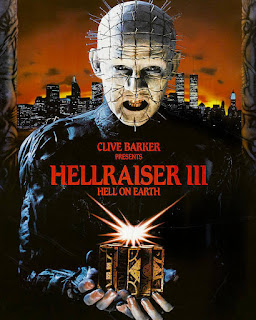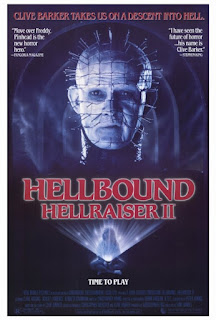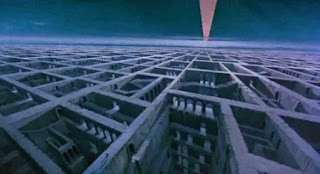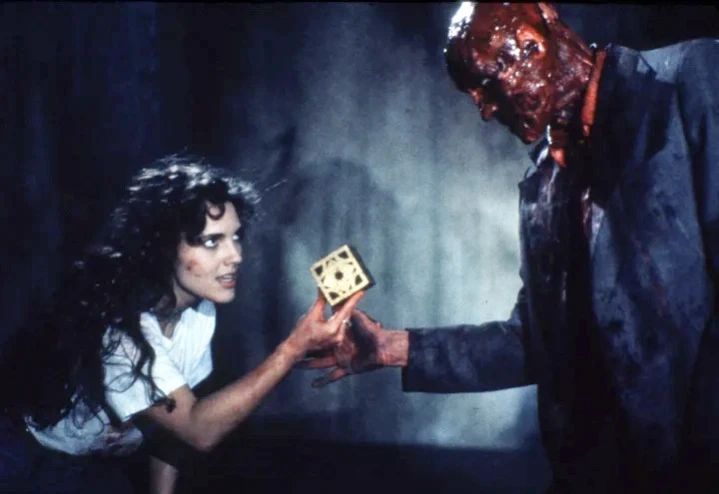Well, we made it.
It’s Halloween here at The Third Row and I’ve now made my way through the complete, at times troubled arc of Clive Barker’s Hellraiser.
Time to sit back and…wait, what?
Well, this changes things.
So, in my earlier telling of the behind the scenes history of this series, there is one detail I must confess I omitted. I want to say that was my way of cleverly teeing up this article, but I’d be lying. This intro is just a happy accident.
While Miramax was engaged in its long game of Kick the Intellectual Property Can with tenuous sequel after tenuous sequel, there was an effort, starting back in 2007 to try and reboot Hellraiser. Whether this was because they recognized the sequels were getting stale and farmed out, or they simply felt a fresh start was the key for new audiences, I’m not sure. Whatever the reason, they recognized the need for a reset.
For a long time, these attempts fared even less favorably than the sequels they kept churning out to hold the brand. Writers and directors were swapped in and out, with little to show for their efforts.
Two things happened that ultimately got the ball moving again -
First, David Gordon Green’s 2018 Halloween reboot/sequel played to critical and financial success that showed there was still potential in revisiting a classic with the right approach.
Second, and more importantly, after years of the series being out of his hands or involvement, Clive Barker was able to legally regain the American rights for Hellraiser.
So not only was the reboot moving forward, the circumstances were right for the original creator to rejoin as an executive producer.
Finally, in October of this year, the movie officially premiered - the first Hellraiser to debut to streaming.
And with that preamble and very long road getting here, I have to say - it was a pleasant surprise.
How pleasant? Well, let’s dig into that.
First off, let me emphasize the use of the term ‘reboot.’ This is completely separated from the prior ten movies. That lack of continuity baggage frees director David Bruckner and the writers (David S Goyer, Luke Piotrowski, and Ben Collins) to tell a story that feels both thematically familiar and also different.
The familiar, to start, feels like a very welcome return to the early movies. While the Cenobites are prominently featured in the marketing (as seen above), and they are certainly a menacing force in the film, they aren’t the focus the way the series made them over time. Instead, this goes back to the two major aspects of the early years - the puzzle box and the people who are, one way or another, drawn to it.
In particular, we have two people who bring two very different perspectives on the accursed object. At the start, we have Voight (Goran Višnjić), who fits the more traditional mold as a wealthy, powerful man who comes to the box to sate his worldly desires, no matter the cost. Subsequently, it winds up in the hands of Riley (Odessa A’zion), a recovering addict who first comes across the box as a trinket to pawn and is then drawn into its mysteries by chance, unaware of what she is toying with until it is too late.
Mystery around the series lore is a big part of what sets this movie apart from much of the run before it. Besides the fact that Riley doesn’t fully understand just what she’s become a part of at first, the movie also offers a different perspective on what the iconic infernal device offers. This time, it doesn’t just present itself as an object for thrill-seekers, but instead offers a broader series of desires to fulfill, provided one completes the puzzle’s necessary steps.
And among those steps, is a steep price to be paid, of course.
This is one of the aspects that I appreciated the most after how convoluted the roles of the box and the Cenobites have been for the better part of twenty years. The vision this movie offers feels more in line with the diabolical nature that Barker first floated, and the contrast between those who would seek it by choice vs those who would be bound to it by chance. Even our hero’s desires, while born of good intent, are framed in this dark world as coming with a bloody toll, and the final payoff may not be as good as it sounds.
For their part, the Cenobites are also a welcome return to form. Rather than the later movies where they are seen as the main monsters (okay, mostly just the one) with the box as part of the package, the group once again serves to fulfill the will of the box, and by extension, Leviathan. Outside of this aspect, I’m a bit more divided. As the good goes, these are some of the best looking Cenobites the films have had in ages, especially as the post-Bloodline movies seemed to default to very generic designs for anyone that wasn’t Pinhead. The designs this time are visually striking and unique, and in a few cases feel informed by The Hellbound Heart, most notably in the case of the Weeper.

This wound up reminding me a LOT of the Cenobite
originally framed as the leader in The Hellbound Heart.
Of course, once again, the primary focus is on the one with all the pins. True to Barker’s wishes, the character is credited as the Priest, and is now played by actress Jamie Clayton. When the casting was first announced, I was intrigued, knowing her skills as an actress, but still uncertain without knowing how the role would be played. Having seen the finished product, she is easily the MVP of the movie. Rather than make another Doug Bradley, as the later sequels tried and failed, she brings her own spin to the role, exuding a presence that is menacing as well as otherworldly.
There is one scene I want to shout out in particular, but I also don’t wish to give too much away. It’s about halfway into the movie, during a scene involving one of the people the box has marked to be sacrificed. Watching it, I was genuinely pleased, both with Clayton’s performance, and for the fact it was one of the scenes that feels the most like the role the Cenobites served in The Hellbound Heart - creatures to whom it’s not about a quick death, but about exploring new levels of pain and pleasure with mortals as their unwilling canvas.
"Oh no, she's hot."
Conceptually, there is a lot I love about this movie. Unfortunately, that doesn’t always carry over visually. One reveal involving a character’s granted wish (I won’t say further as this is still fairly recent) is a big example. The idea we’re presented is very Barker, and it is honestly one of the creepiest concepts in the movie. Presentation-wise, however, the on-screen product looks lackluster and doesn't sell the nightmarish aspects as strongly. Likewise, as striking and inspired as the new Cenobites look (and the practical effects for them are solid), their arsenal is marred by the awkward CG of the movie’s straight to streaming budget.
The other issue I have, albeit a smaller one, is that at two hours, this is the longest Hellraiser movie to date. While it doesn’t feel like it drags to the point of distraction, it is still a movie that feels like a bit of tightening could have taken it from being pretty good to great.
As it is now, there’s a lot to like in it. There is also a lot to improve on, and hearing this has lit a fire under Barker to want to do more with the setting again is encouraging. After over ten years of watching this series run on fumes, this is the first time I’ve felt like the series had some energy in it, and, even with its faults, that rubbed off on me in the process.
I’m interested in seeing where they go from here, anyway. Especially if Barker continues to serve as producer and Clayton is there to continue to collect victims to pay for Leviathan's offerings.
I’m glad this is the note we’re going out on. As much as I loved the start of this series, the middle was a really draining experience. To the point where…well…you saw my read on The Scarlet Gospels, and I still stand by that as a meta-middle finger.
Despite that, it’s refreshing to close with a feeling of something new. Yes, a new Hellraiser in general isn’t exactly the pinnacle of innovation, but to have a Hellraiser that genuinely feels mysterious and engaging again makes me feel like this journey was ultimately worth it.
With that note, it’s time to pack up the franchise spelunking gear for another year and wish you all a Happy Halloween.
…oh, what the Hell! For once, I’ll actually rank this whole experience.
1. Hellraiser (1987)
2. Hellbound: Hellraiser II
3. The Hellbound Heart
4. Hellraiser (2022)
5. Hellraiser: Bloodline (Original script)
6. Hellraiser III: Hell on Earth
7. The Scarlet Gospels
8. Hellraiser: Bloodline (movie)
9. Hellraiser: Inferno
10. Clive Barker’s Tweet disavowing any connection to Hellraiser: Revelations
11. Hellraiser: Hellseeker
12. Hellraiser: Hellworld (again, not good, but at least incredibly fun to riff on)
13. Hellraiser: Deader
14. Hellraiser: Judgment
15. Hellraiser: Revelations
Okay. NOW. Good night and Happy Halloween. With any luck, I’ll be back up to some new chicanery before next October, but we’ll see.






























